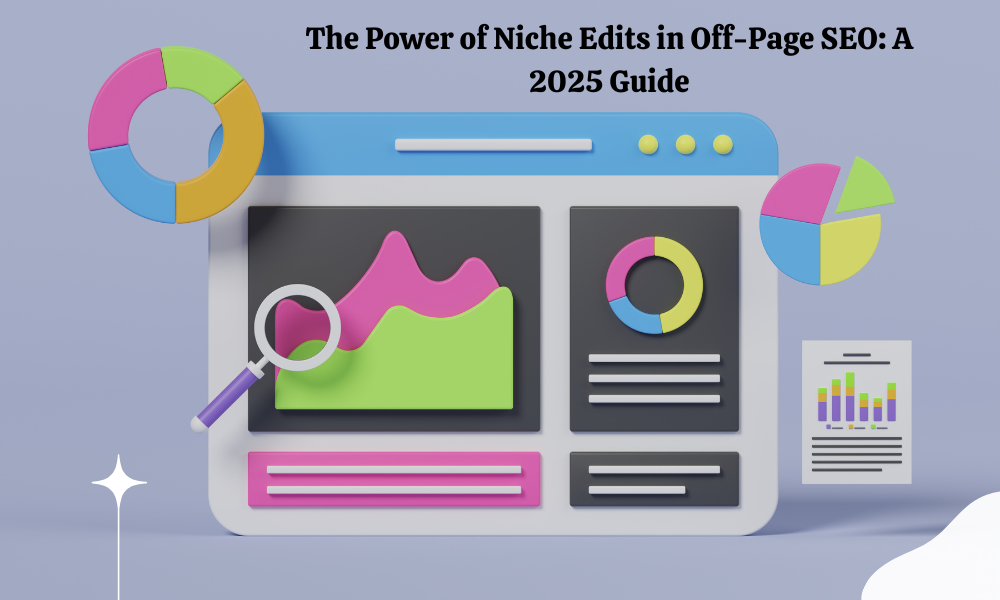The Power of Niche Edits in Off-Page SEO: A 2025 Guide
In the competitive world of SEO, off-page strategies like link building are essential for improving search rankings. While traditional link-building methods like guest blogging and outreach are effective, niche edits offer a unique and powerful way to earn high-quality backlinks. Niche edits involve adding links to your website in existing, relevant content on other websites.
As we move into 2025, niche edits are becoming an increasingly popular and effective off-page SEO strategy. In this guide, we’ll explore the power of niche edits, how they work, and how you can leverage them to boost your SEO and drive more traffic to your website.
What Are Niche Edits?
Niche edits, also known as contextual link insertions, involve adding links to your website in existing content on other websites. Unlike guest blogging, where you create new content, niche edits allow you to insert links into already published articles or blog posts.
Why Niche Edits Are Powerful:
- High-Quality Backlinks: Niche edits often come from authoritative, niche-relevant websites.
- Contextual Relevance: Links are placed within relevant content, making them more valuable for SEO.
- Time-Efficient: Niche edits are quicker to implement than creating new content.
Why Niche Edits Matter for Off-Page SEO
Off-page SEO focuses on activities outside your website that influence your search rankings. Niche edits are a powerful off-page strategy because:
- They Build Authority: Backlinks from authoritative websites signal to search engines that your site is trustworthy and relevant.
- They Drive Referral Traffic: Links placed in high-traffic content can bring targeted visitors to your site.
- They Improve Rankings: Contextual backlinks are highly valued by search engines and can boost your visibility.
In 2025, as search engines prioritize quality and relevance, niche edits will become even more important for off-page SEO.
How to Find Niche Edit Opportunities
Finding the right opportunities for niche edits requires research and strategy. Here’s how to get started:
1. Identify Niche-Relevant Websites
Look for websites in your niche that publish high-quality content and have a strong domain authority.
How to Find Niche-Relevant Websites:
- Use Backlink Analysis Tools: Tools like Ahrefs, SEMrush, and Moz can help you identify websites linking to your competitors.
- Search for Industry Blogs: Look for blogs and websites that cover topics related to your niche.
- Explore Resource Pages: Many websites have resource pages that link to useful content.
Example:
If you run a fitness blog, look for websites that publish content on health, nutrition, and exercise.
2. Analyze Existing Content
Once you’ve identified niche-relevant websites, analyze their existing content for opportunities to insert links.
What to Look For:
- Relevance: Ensure the content is closely related to your niche and target keywords.
- Traffic: Choose content that receives a significant amount of traffic.
- Link Placement: Look for natural opportunities to insert your link, such as in a list of resources or within a relevant section.
Example:
If you find a blog post about “10 Best Exercises for Weight Loss,” you could suggest adding a link to your guide on “How to Create a Weight Loss Workout Plan.”
3. Reach Out to Website Owners
Contact the website owner or editor to propose your niche edit.
How to Craft Your Pitch:
- Be Polite and Professional: Start with a friendly greeting and introduce yourself.
- Explain the Value: Highlight how your link adds value to their content.
- Offer a Trade: If appropriate, offer to link back to their website or provide other incentives.
Example Pitch:
“Hi [Website Owner’s Name],
I came across your article on [Article Title] and found it incredibly insightful. I recently published a related guide on [Your Topic] that I believe would be a valuable addition to your post. Would you consider adding a link to my guide in the [Specific Section]?
Thank you for your time, and I look forward to hearing from you.
Best,
[Your Name]”
Best Practices for Niche Edits
To maximize the effectiveness of niche edits, follow these best practices:
1. Focus on Quality Over Quantity
A few high-quality niche edits are more valuable than numerous low-quality ones.
How to Ensure Quality:
- Choose Authoritative Websites: Prioritize websites with high domain authority and relevance to your niche.
- Ensure Contextual Relevance: Place your links in content that is closely related to your target keywords.
2. Use Natural Anchor Text
Avoid over-optimizing your anchor text, as this can look spammy and trigger penalties.
How to Use Anchor Text Effectively:
- Mix It Up: Use a combination of branded, generic, and long-tail anchor text.
- Keep It Natural: Ensure the anchor text flows naturally within the content.
Example:
Instead of always using “best fitness tips,” vary your anchor text with phrases like “learn more,” “check out this guide,” or “fitness advice.”
3. Monitor Your Backlinks
Regularly track your niche edits to ensure they’re included and functioning properly.
How to Monitor Backlinks:
- Use Backlink Analysis Tools: Tools like Ahrefs, SEMrush, and Moz can help you track your backlinks.
- Check the Content: Visit the published article to confirm your link is included.
4. Build Relationships
Establishing relationships with website owners and editors can lead to more niche edit opportunities in the future.
How to Build Relationships:
- Engage on Social Media: Follow and interact with website owners on platforms like Twitter and LinkedIn.
- Provide Value: Share their content and offer helpful insights to build goodwill.
Tools to Find and Manage Niche Edits
Here are some tools to help you find and manage niche edit opportunities:
1. Ahrefs
- Analyze competitor backlinks and identify niche-relevant websites.
2. SEMrush
- Track your backlinks and discover new niche edit opportunities.
3. BuzzStream
- Manage your outreach efforts and build relationships with website owners.
4. Hunter
- Find email addresses for website owners and editors.
5. Moz Link Explorer
- Analyze your backlink profile and identify high-quality links.
Common Mistakes to Avoid
Avoid these pitfalls to make the most of niche edits:
1. Overloading with Links
Adding too many links to a single piece of content can look spammy and harm your SEO.
2. Ignoring Relevance
Links placed in irrelevant content provide little SEO value and can hurt your rankings.
3. Neglecting to Follow Up
If a website owner agrees to your niche edit, follow up to ensure the link is added.
4. Using Low-Quality Websites
Niche edits from low-quality or spammy websites can harm your SEO efforts.
Niche edits are a powerful and efficient way to earn high-quality backlinks and boost your off-page SEO. By inserting links into relevant, authoritative content, you can improve your search rankings, drive more traffic, and establish your website as an authority in your niche.
As we move into 2025, leveraging niche edits will become even more important as search engines prioritize quality and relevance. Start implementing these strategies today, and watch your website climb the search rankings while building a strong backlink profile.




